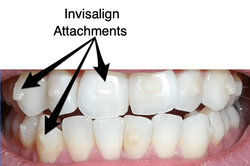Frequently Asked Questions Regarding Invisalign: Everything You Need to Know
Frequently Asked Questions Regarding Invisalign: Everything You Need to Know
Blog Article
Invisalign vs. Conventional Dental braces: Which Alternative Is Right for You?
When considering orthodontic treatment, the option in between Invisalign and traditional dental braces presents several important elements that warrant mindful assessment. Invisalign provides a very discreet alternative with removable aligners, while typical dental braces provide a more visible yet efficient remedy for extreme imbalance.
Overview of Treatment Choices

In comparison, traditional dental braces are composed of metal brackets and wires that are adhered to the teeth. This method applies constant pressure in time to achieve placement. While effective for complex orthodontic concerns, traditional dental braces need normal gos to for modifications and can pose difficulties in preserving oral health as a result of the trouble of cleaning up about wires and brackets.
Both alternatives have their merits, and the choice usually rests on specific oral conditions, lifestyle preferences, and client conformity. Inevitably, speaking with an orthodontic specialist is critical for establishing the most suitable therapy strategy customized to private requirements. Comprehending the subtleties of each choice can substantially influence the general success of orthodontic treatment.
Aesthetic Factors To Consider
A considerable factor influencing the choice in between Invisalign and standard dental braces is the visual appeal each therapy supplies. Invisalign aligners are crafted from clear plastic, making them practically undetectable when used.
On the other hand, traditional dental braces are composed of steel braces and cables, which can be much more recognizable. While improvements in orthodontic modern technology have actually brought about the advancement of smaller sized braces and colored elastics, typical braces still keep a more noticeable account. For some individuals, the exposure of braces might discourage them from looking for necessary treatment.
Inevitably, the option in between Invisalign and conventional dental braces might pivot on personal choices pertaining to aesthetics. Individuals that prioritize discretion commonly lean towards Invisalign, while those that are much less concerned regarding exposure might choose standard braces. Comprehending the aesthetic ramifications of each option is important for making a notified choice that straightens with one's lifestyle and preferences.
Convenience and Convenience

In terms of comfort, Invisalign aligners are detachable, enabling individuals to appreciate their preferred foods without constraint and keep optimum oral hygiene. Cleaning and flossing are streamlined, as the aligners can be secured throughout these routines, whereas typical dental braces require careful maneuvering around brackets and wires.
In contrast, traditional dental braces require regular changes, making them much less hassle-free for those with hectic schedules. On the whole, the convenience and convenience of Invisalign make it an enticing selection for lots of individuals looking for orthodontic treatment.
Treatment Period and Efficiency
While both Invisalign and standard braces work in fixing oral misalignments, the period of therapy can vary considerably in between both choices. Generally, Invisalign therapy can take anywhere from 12 to 18 months, relying on the complexity of the instance. The clear aligners work by progressively shifting teeth into their wanted positions, and normal follow-ups with an orthodontist assistance make certain progress stays on course.
In contrast, typical dental braces frequently need a longer dedication, usually ranging from 18 months to 3 years. This results from their set nature and the usage of cords and brackets, which can be a lot more reliable for complicated instances and click to read extreme imbalances (Invisalign). The therapy effectiveness of standard dental braces is well-documented, as they permit precise modifications and greater control over tooth activity
Inevitably, the selection in between Invisalign and traditional braces may pivot on both the awaited therapy period and the details oral concerns handy. Consulting with an orthodontist is critical, as they can supply tailored recommendations based on individual needs, guaranteeing the picked method aligns with desired outcomes and durations.
Expense Contrast and Insurance Alternatives
Price plays a substantial function in the decision-making process for people taking into consideration orthodontic therapy, whether selecting Invisalign or typical dental braces. Generally, the cost of Invisalign arrays from $3,000 to $8,000, while typical dental braces normally cost between $2,000 and $6,000. Variables affecting these costs consist of the complexity of the instance, the period of treatment, and geographical location.
Many oral insurance coverage plans supply partial protection for orthodontic therapies, yet the specifics can differ commonly. Usually, traditional braces may be a lot more often covered by insurance strategies compared to Invisalign, which some insurance providers classify as an aesthetic treatment.
Additionally, a number of orthodontic techniques use flexible repayment strategies, making from this source both therapy alternatives more easily accessible. People ought to make inquiries concerning possible financing options and discounts for in advance settlements. Examining the overall expense, consisting of insurance policy advantages and settlement strategies, is important for making an educated choice that straightens with both visual choices and spending plan factors to consider.

Verdict
In summary, the choice in between Invisalign and standard braces pivots on numerous elements, consisting of aesthetic choices, comfort, therapy duration, and price. Invisalign uses a discreet, detachable choice that facilitates dental hygiene and dietary flexibility, while typical braces might be better for complicated oral issues and commonly come with a lower rate point. Inevitably, examination with an orthodontist is important to examine individual scenarios and determine one of the most ideal treatment choice for attaining optimal oral alignment.
When thinking about orthodontic therapy, the selection between Invisalign and conventional dental braces offers several crucial variables that merit careful examination.Contrasting Invisalign and typical braces exposes distinctive treatment options for orthodontic adjustment.While both Invisalign and standard dental braces are reliable in dealing with dental imbalances, the period of therapy can differ significantly between the two alternatives.Cost plays a considerable function in the decision-making procedure for individuals thinking about orthodontic treatment, whether choosing for Invisalign or standard dental braces.In recap, the selection in between Invisalign and typical dental braces pivots on several look here aspects, including aesthetic preferences, convenience, therapy period, and expense.
Report this page